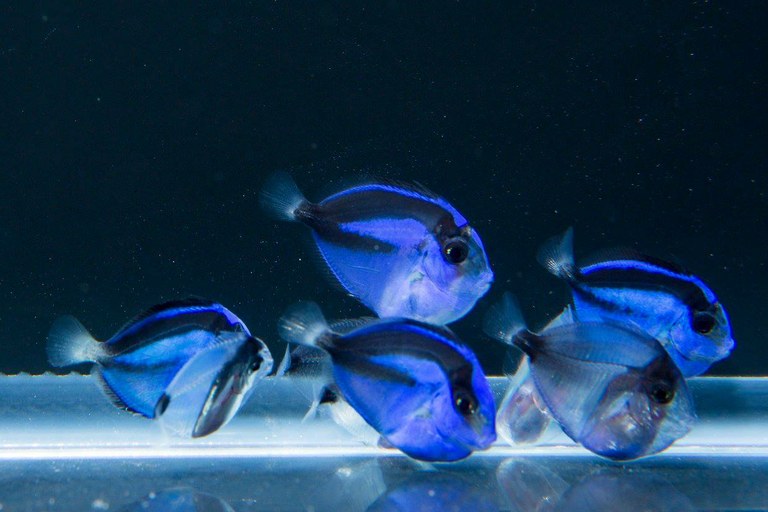
Pacific Blue Tang (Paracanthurus hepatus) juveniles – 55dph. Approximately 25mm long (slightly larger than a quarter). Blue and black coloration developing. No yellow yet. Photo by Tyler Jones.
Craig Watson, director of the University of Florida Tropical Aquaculture Laboratory, wrote an outstanding article for Reef to Rainforest about the history of this exciting breakthrough. A lot of progress has been made with ornamental marine fish aquaculture in recent years. Our heartfelt admiration for all the good people and companies who have made these successes possible.
Below is the joint statement by Rising Tide Conservation and the University of Florida Tropical Aquaculture Laboratory:
Rising Tide Conservation and the UF Tropical Aquaculture Lab Announce Ocean Conservation Breakthrough Success Raising Pacific Blue Tangs “Dory Fish”
Rising Tide Conservation in partnership with the University of Florida announces the first successful culture of Pacific Blue Tang fish, the species known as the character “Dory”. This major breakthrough is an advance in reef conservation and a key step forward in aquaculture of marine ornamental fish. Until today, all Pacific Blue Tangs were collected from reefs primarily in Indonesia or the Philippines. Aquacultured tangs from these trials are not currently for sale. It is expected that a small number of these “first blue tangs” will be available for sale in August or September.
Dr. Judy St. Leger, president of Rising Tide Conservation states “This is a new chapter in ornamental fish aquaculture. Both display aquariums and fish hobbyists can now choose where many of their fish come from. Collecting reef fish is a complex issue with both positives and negatives. Having aquaculture alternatives can benefit fish, people, and reefs.”
This major breakthrough is a key step forward in aquaculture of marine ornamental fish. Until today, all Pacific blue tang fish were collected from reefs primarily in Indonesia or the Philippines.
The advance was made possible by the efforts of a committed team of biologists including Eric Cassiano and Kevin Barden at the Tropical Aquaculture Laboratory of the University of Florida in Ruskin, Florida. The laboratory is directed by Craig Watson and Dr. Matt DiMaggio oversees integration with Rising Tide Conservation. Rising Tide Conservation identified this species as one of conservation interest for aquaculture in 2010.
Craig Watson, director of the University of Florida Tropical Aquaculture Laboratory commented “This team is a can-do part of Rising Tide Conservation. We are committed to improving the science of raising fish and we are proud to be part of the Rising Tide program. Our folks are a successful team because of their knowledge, commitment, and ability to work with others to reach a common goal. Eric and Kevin gave up their weekends and holidays this summer to make this happen. I could not be more proud of them than I am today.”
Efforts have been underway to develop techniques for rearing this fish in both Florida and Hawaii at the Oceanic Institute of Hawaii Pacific University. Dr. Chad Callan of the Oceanic Institute commented, “The basis of Rising Tide Conservation is communication and sharing. This breakthrough came, in part from methods for propagating yellow tang here in Hawaii. We expect many more species to be successfully produced using the techniques that made these two iconic tangs possible.”
Get the whole story from our Facebook page:
https://www.facebook.com/risingtideconservation/
Pacific blue tangs (Paracanthurus hepatus) are marine fish that have a broad natural distribution in the reefs in Indo-Pacific ocean regions. They are popular in both home and display aquaria – but they are not a pet for everyone. They have special feeding requirements and can grow up to 1 foot or more in length. They require a large, 100 to 200 gallon, well-balanced marine environment to thrive. For more information on how to care for saltwater and freshwater fish visit any of the following websites: http://www.myrightfish.com, http://www.liveaquaria.com or http://www.petco.com/fish.
The blue tangs from these trials are not currently available for sale. It is expected that a small number of these “first blue tangs” will be available in August or September. On day 52 post hatching, the first “baby Dory” was photographed, not on an IndoPacific reef, but in a greenhouse in Ruskin, Florida.
####
About Rising Tide Conservation:
Established in 2009, Rising Tide Conservation is non-profit entity dedicated to coral reef conservation. The program develops sustainable aquaculture alternatives to collecting marine ornamental fish from reefs. Rising Tide is composed of integrated stakeholders from the public aquaria and zoo communities, research institutes and universities, tropical fish producers, wholesalers and retailers as well as numerous businesses and organizations in the hobby fish industry. Research facilities include the University of Florida and the Oceanic Institute of Hawaiian Pacific University. Major funding stakeholders include the international retailer, Petco and the SeaWorld-Busch Gardens Conservation Fund. For more information, go to http://www.risingtideconservation.org
About the Tropical Aquaculture Laboratory of the University of Florida:
Established in 1996 the Tropical Aquaculture Laboratory is part of the University of Florida’s Institute of Food and Agriculture Sciences, and falls within the School of Forest Resources and Conservation. Its primary mission is to provide scientific research and extension support to Florida’s unique ornamental fish industry. Located in Ruskin, the lab includes both indoor and outdoor research facilities on a 6.5 acre fish farm, a disease diagnostic lab, and partners with the USDA and Hillsborough County Community College which operate out of the facility. Go to tal.ifas.ufl.edu for more information.









0 Comments